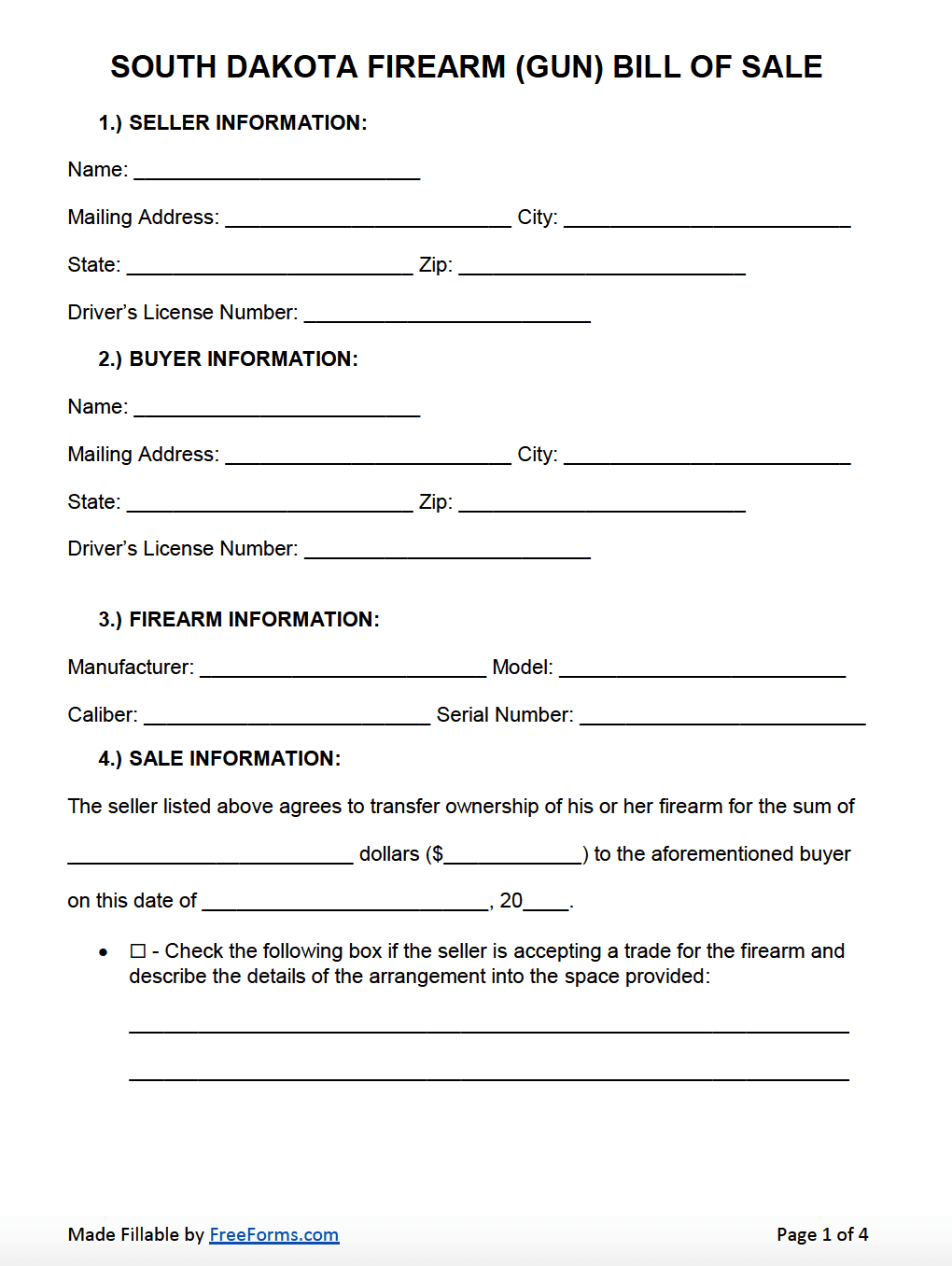The South Dakota firearm (gun) bill of sale form constitutes a bond between seller and purchaser of a firearm, demonstrating the terms of the transaction in writing. The detailed account forms a legal bond between the seller and buyer, committing the agreement to confirmed language once endorsed. This form will need to be signed in the presence of an authorized notary public.
How to Register a Gun
South Dakota’s state laws do not cite any requirement of registration for a resident to possess a firearm. There also no prerequisites to obtaining a permit or license to purchase a gun, and anyone aged 18 or older has the right to do so. When purchasing a gun from a federally licensed firearms dealer, an application must be filled out and filed within 6-hours from the time of purchase, either by mail or at the local county sheriff’s office. This application process is waived for those actively possessing a concealed carry license. Open carry of a long gun is granted with the stipulation that, if carried in a vehicle, it must be in plain view to be deemed legal open carry. One may possess and conceal a long gun or handgun within their own domicile or at an owner’s private place of business without the requirement of furnishing a concealed carry permit.
How to Obtain a Concealed Carry Weapons Permit
To carry a concealed handgun within the state, a resident must further apply for a concealed weapons permit (per SDCL 22-14-9). This permit affords an additional advantage to travel with reciprocity within accepted US States. In the state of South Dakota, there are a total of 3 different permit types that allow for open carry, each with a varied range of reciprocity states. The regular Open Carry Permit covers reciprocity within 31 states other than South Dakota for the minimal $10 fee. The next tier is the South Dakota Gold Card Concealed Carry Weapons Permit for a $70 fee, which allows for reciprocity to carry the weapon in the supplementary state of Wisconsin. The top-tier licensure is available in the South Dakota Enhanced Concealed Carry Weapons Permit for a fee of $100. This permit allows for concealed carry in the previously approved reciprocity states and further consists of 7 other states including Nebraska and Minnesota. This permit does require special weapons safety training by an approved instructor at an additional fee.
To apply for a concealed carry weapons permit, deliver the following documents, in person, to your local county sheriff’s office:
- A filed South Dakota Concealed Pistol Permit Application.
- A completed fingerprint identification card (available on-site for a fee).
- Certification of completion of a recognized weapons safety program (for the SD Enhanced CCW Permit).
- An active photo ID.
- Payment for permit fees, background check, and fingerprint fees.
Once your application is completed and handed into the sheriff’s office, you will be issued a temporary permit within a week’s time, upon approval. The official permit will then be mailed to you within a month. Permits are active for a period of 5 years before they will need to be renewed.
How to Write
Step 1 – Attain a copy of the digital form by selecting the link for the Adobe PDF.
Step 2 – Seller Information – Include all pertinent information relevant to the seller of the weapon:
- Name
- Mailing Address
- City
- State
- Zip Code
- Driver’s License
Step 3 – Buyer Information – Enter the same information associated with the buyer:
- Name
- Mailing Address
- City
- State
- Zip Code
- Driver’s License
Step 4 – Firearm – Complete the section provided for information with respect to the firearm being transferred:
- Manufacturer
- Model
- Caliber
- Serial number
Step 5 – Sale Information – Submit all necessary information about the sale price and terms.
- Purchase Price (in words)
- Purchase Price (numerical)
- Purchase Date
- There is a space allocated to include any information regarding trade information if applicable. You can identify any items involved in a trade in this area, including make, model, and serial number(s).
Step 6 – Disclosure Statements – Endorse upon agreement to both the seller and buyer disclosure statements.
Step 7 – Signatures – Have the signatures be performed with the supervision and acceptance of a professional notary, and should you so choose, corroborating witnesses.



0 comments
Comments are closed.